

Compact Muon Solenoid
LHC, CERN
| CMS-PAS-TOP-20-003 | ||
| Measurement of the cross section of top quark pair production with additional charm jets using the dileptonic final state in pp collisions at √s= 13 TeV | ||
| CMS Collaboration | ||
| September 2020 | ||
| Abstract: For the first time, a measurement of the inclusive cross section of top quark pair (tˉt) production with two additional charm jets is presented. The measurement is performed using the dileptonic decay channel of the top quark pairs produced in proton-proton collisions at a centre-of-mass energy of 13 TeV. The used dataset corresponds to an integrated luminosity of 41.5 fb−1, collected with the CMS detector at the LHC. A neural network is trained to distinguish between top quark pair events with additional c jets (tˉtcˉc), b jets (tˉtbˉb), and light-flavour jets (tˉtLF), based on observables related to dedicated charm jet identification algorithms, as well as kinematic properties of the event. By means of a template fitting procedure using simulated and observed neural network outputs, the inclusive tˉtcˉc, tˉtbˉb, and tˉtLF cross sections are simultaneously extracted, together with their ratios to the inclusive tˉt + two jets cross section. This results in a fully coherent treatment of different additional jet flavours in the production of tˉt + two jets, and provides the first measurement of the tˉtcˉc process with a measured cross section of 0.152 ± 0.022 (stat.) ± 0.019 (syst.) pb in the fiducial phase space and 7.43 ± 1.07 (stat.) ± 0.95 (syst.) pb in the full phase space. | ||
|
Links:
CDS record (PDF) ;
CADI line (restricted) ;
These preliminary results are superseded in this paper, Submitted to PLB. The superseded preliminary plots can be found here. |
||
| Figures & Tables | Summary | Additional Figures | References | CMS Publications |
|---|
| Figures | |
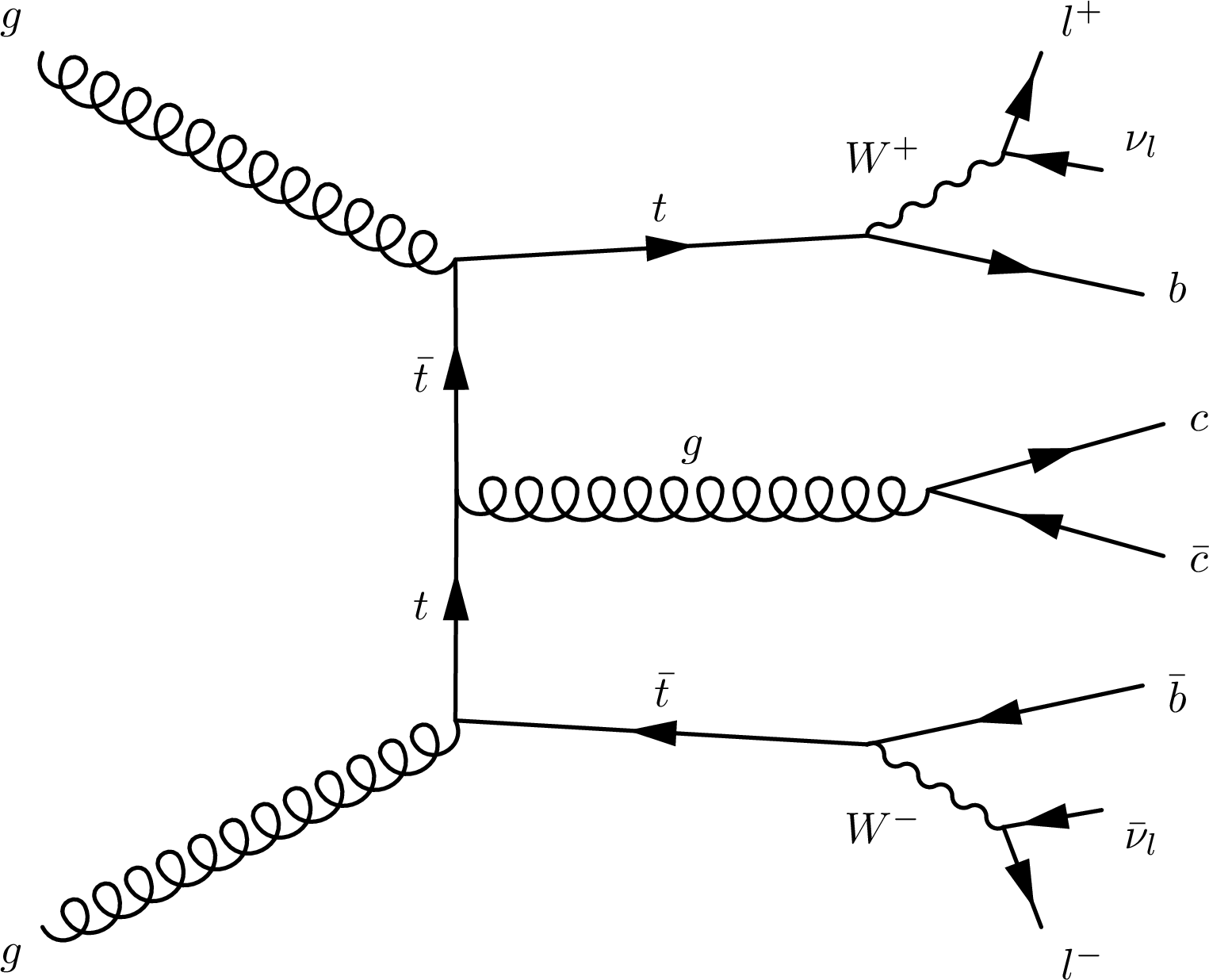
png pdf |
Figure 1:
Example of a Feynman diagram describing the dileptonic decay channel of a top quark pair with two additional c quarks produced via gluon splitting. |

png pdf |
Figure 2:
Comparison between the data (points) and the simulated predictions (histograms) for the distribution of the neural network score for the best permutation found in each event. Underflow is included in the first bin. |

png pdf |
Figure 3:
Comparison between the data (points) and the simulated predictions (histograms) for the CvsL (left) and CvsB (right) c-tagging discriminator distributions of the first additional jet, before (top) and after (bottom) the c-tagging calibration is applied. |

png pdf |
Figure 3-a:
Comparison between the data (points) and the simulated predictions (histograms) for the CvsL c-tagging discriminator distributions of the first additional jet, before the c-tagging calibration is applied. |
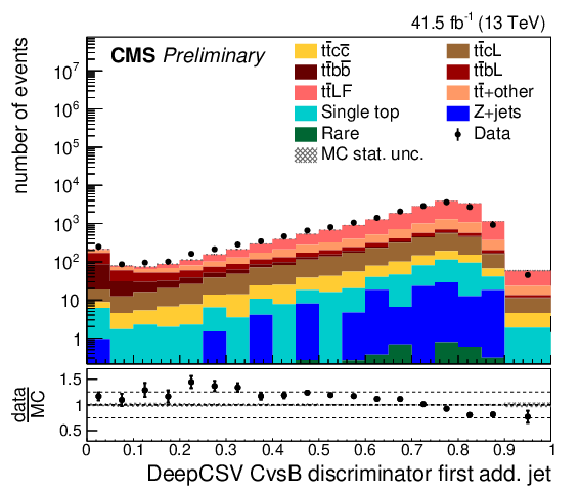
png pdf |
Figure 3-b:
Comparison between the data (points) and the simulated predictions (histograms) for the CvsB c-tagging discriminator distributions of the first additional jet, before the c-tagging calibration is applied. |

png pdf |
Figure 3-c:
Comparison between the data (points) and the simulated predictions (histograms) for the CvsL c-tagging discriminator distributions of the first additional jet, after the c-tagging calibration is applied. |

png pdf |
Figure 3-d:
Comparison between the data (points) and the simulated predictions (histograms) for the CvsB c-tagging discriminator distributions of the first additional jet, after the c-tagging calibration is applied. |

png pdf |
Figure 4:
Normalised two-dimensional distributions of ΔcL on the x-axis and Δcb on the y-axis in simulated dileptonic top quark pair events after the event selection outlined in Sec. 5. |

png pdf |
Figure 5:
A one-dimensional representation of the two-dimensional ΔcL and Δcb distributions, in the simulation and in data after scaling the simulated templates according to the fitted cross sections. The bottom panel shows the ratio of the yields in data to those in the simulation. The brown (grey) uncertainty band denotes the statistical uncertainty from the fit (the statistical and systematic uncertainties combined). The signal strengths μtˉtcˉc, μtˉtbˉb and μtˉtLF are also shown with their uncertainties (not including theoretical uncertainties on the NNLO tˉt cross section). |
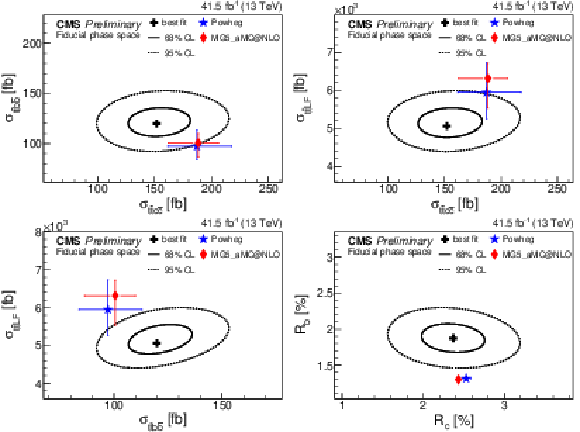
png pdf |
Figure 6:
Results of the two-dimensional likelihood scans for several combinations of the parameters of interest in the fiducial phase space. The best fitted value (black cross) with the corresponding 68% (full) and 95% (dashed) confidence level contours are shown, compared to the theory predictions using either the {POWHEG} (blue star) or MG5_aMC@NLO (red diamond) matrix element generators. Uncertainties on the theoretical predictions are displayed by the horizontal and vertical error bars on the markers. |
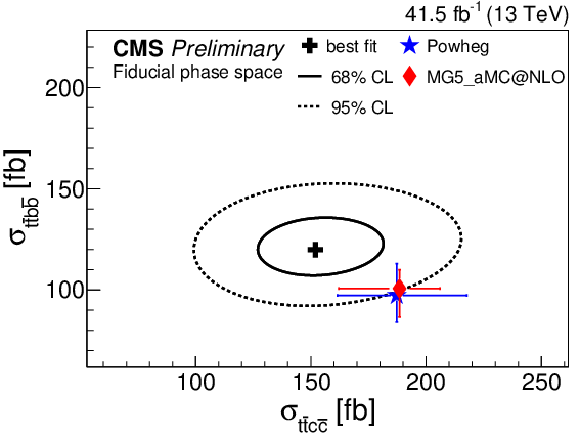
png pdf |
Figure 6-a:
Results of the two-dimensional likelihood scans for σtˉtbˉb vs σtˉtcˉc in the fiducial phase space. The best fitted value (black cross) with the corresponding 68% (full) and 95% (dashed) confidence level contours are shown, compared to the theory predictions using either the {POWHEG} (blue star) or MG5_aMC@NLO (red diamond) matrix element generators. Uncertainties on the theoretical predictions are displayed by the horizontal and vertical error bars on the markers. |
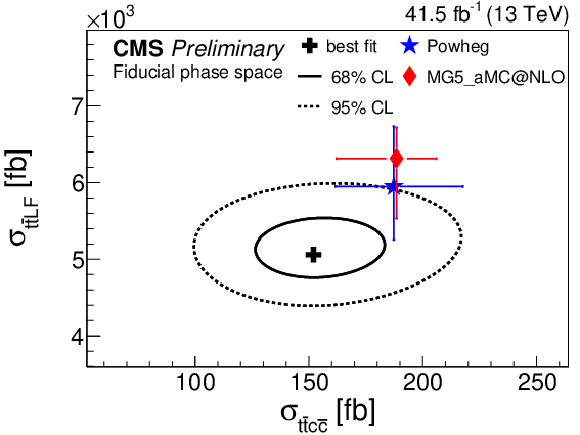
png pdf |
Figure 6-b:
Results of the two-dimensional likelihood scans for σtˉtLF vs σtˉtcˉc in the fiducial phase space. The best fitted value (black cross) with the corresponding 68% (full) and 95% (dashed) confidence level contours are shown, compared to the theory predictions using either the {POWHEG} (blue star) or MG5_aMC@NLO (red diamond) matrix element generators. Uncertainties on the theoretical predictions are displayed by the horizontal and vertical error bars on the markers. |

png pdf |
Figure 6-c:
Results of the two-dimensional likelihood scans for σtˉtLF vs σtˉbcˉb in the fiducial phase space. The best fitted value (black cross) with the corresponding 68% (full) and 95% (dashed) confidence level contours are shown, compared to the theory predictions using either the {POWHEG} (blue star) or MG5_aMC@NLO (red diamond) matrix element generators. Uncertainties on the theoretical predictions are displayed by the horizontal and vertical error bars on the markers. |

png pdf |
Figure 6-d:
Results of the two-dimensional likelihood scans for Rb vs Rc in the fiducial phase space. The best fitted value (black cross) with the corresponding 68% (full) and 95% (dashed) confidence level contours are shown, compared to the theory predictions using either the {POWHEG} (blue star) or MG5_aMC@NLO (red diamond) matrix element generators. Uncertainties on the theoretical predictions are displayed by the horizontal and vertical error bars on the markers. |
| Tables | |

png pdf |
Table 1:
Selection efficiencies and acceptance factors for events in different signal categories. These values were derived from simulated top quark pair events. |
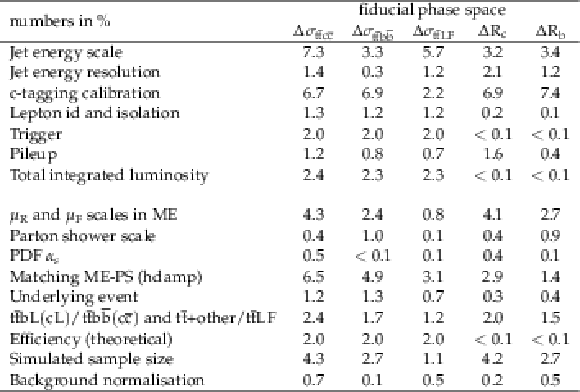
png pdf |
Table 2:
Summary of the individual impacts of the uncertainties on the different parameters of interest in the fiducial phase space. The upper (lower) rows of the table list uncertainties related to the experimental conditions (theoretical modelling). |

png pdf |
Table 3:
Results on the parameters of interest in the fiducial and full phase space with uncertainties. The last two columns display the theoretical predictions from the simulated top quark pair samples using either POWHEG or MG5_aMC@NLO as a matrix element generator. The uncertainty quoted for these predictions includes uncertainties from variations of the QCD scales (μR and μF) in the ME, α|textS uncertainties in the PS and in the proton PDF, uncertainties related to the underlying event and the matching between the ME and the PS (hdamp), as well as the uncertainty on the NNLO tˉt cross section. |
| Summary |
|
The production of a top quark pair in association with additional bottom or charm jets at the LHC presents challenges both in the theoretical modelling as well as in the experimental measurement of this process. Whereas the tˉtbˉb process has been measured by the CMS and ATLAS collaborations at different centre-of-mass energies, this analysis presents the first measurement of the tˉtcˉc cross section. The analysis is conducted using a data sample of proton-proton collision events collected by the CMS experiment at a centre-of-mass energy of 13TeV, corresponding to an integrated luminosity of 41.5 fb−1. The measurement is performed in the dileptonic decay channel of the top quark pairs and relies on the use of recently developed charm-jet identification algorithms. A template fitting method is used, based on the outputs of a neural network classifier that is trained to identify the different signal categories defined by the flavour of the additional jets. This allows the simultaneous extraction of the tˉtcˉc, tˉtbˉb and tˉtLF cross sections, as well as the ratios Rc=σtˉtcˉc/σtˉtjj and Rb=σtˉtbˉb/σtˉtjj. A novel calibration of the full shape of the c-tagging discriminator distributions is employed, such that this information can be reliably used in the neural network classifier. The tˉtcˉc cross section is measured to be 0.152 ± 0.022 (stat.) ± 0.019 (syst.) pb in the fiducial phase space and 7.43 ± 1.07 (stat.) ± 0.95 (syst.) pb in the full phase space. The ratio Rc is found to be 2.37 ± 0.32 (stat.) ± 0.25 (syst.)% in the fiducial phase space and 2.64 ± 0.36 (stat.) ± 0.28 (syst.)% in the full phase space. An overall agreement is observed between the measured values and the theoretical predictions at the level of one to two standard deviations for the tˉtcˉc, tˉtbˉb and tˉtLF processes. The largest disagreement is observed for the ratio Rb, at the level of 2.5 standard deviations, which nevertheless is found to be consistent with observations from previous analyses [4,5,6,7,8,9,10] targeting specifically this final state. |
| Additional Figures | |
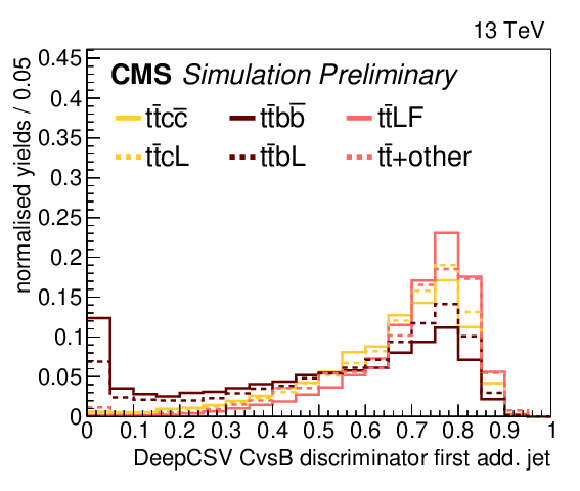
png pdf |
Additional Figure 1:
Normalised distribution of the DeepCSV CvsB discriminator for the first additional jet for different signal categories in simulated dileptonic top quark pair events. |

png pdf |
Additional Figure 2:
Normalised distribution of the DeepCSV CvsL discriminator for the first additional jet for different signal categories in simulated dileptonic top quark pair events. |
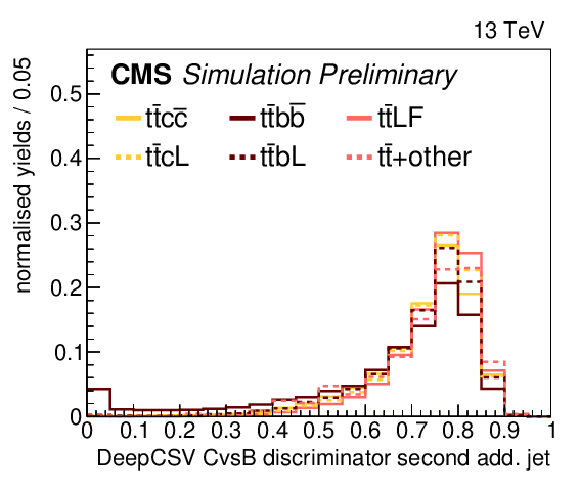
png pdf |
Additional Figure 3:
Normalised distribution of the DeepCSV CvsB discriminator for the second additional jet for different signal categories in simulated dileptonic top quark pair events. |

png pdf |
Additional Figure 4:
Normalised distribution of the DeepCSV CvsL discriminator for the second additional jet for different signal categories in simulated dileptonic top quark pair events. |
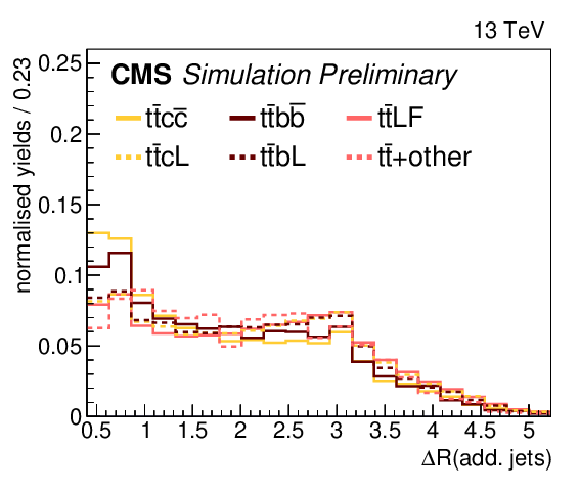
png pdf |
Additional Figure 5:
Normalised distribution of the angular separation in ΔR between the two additional jets for different signal categories in simulated dileptonic top quark pair events. |

png pdf |
Additional Figure 6:
Normalised distribution of the neural network score for the best permutation found in each event for different signal categories in simulated dileptonic top quark pair events. |
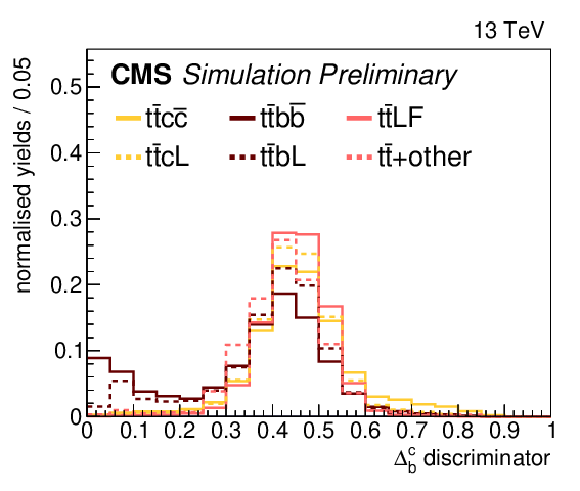
png pdf |
Additional Figure 7:
Normalised distribution of the Δcb discriminator for different signal categories in simulated dileptonic top quark pair events. |
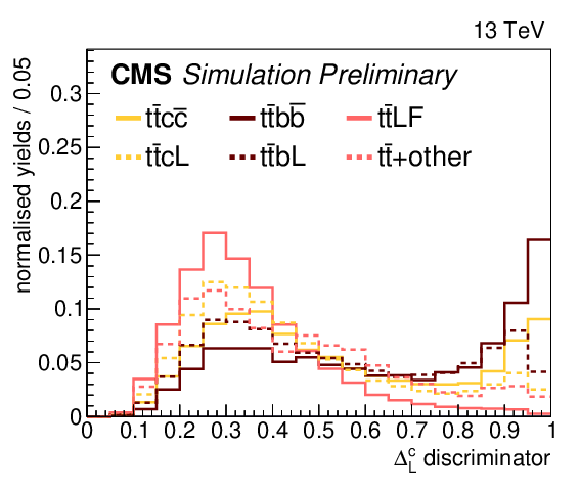
png pdf |
Additional Figure 8:
Normalised distribution of the ΔcL discriminator for different signal categories in simulated dileptonic top quark pair events. |
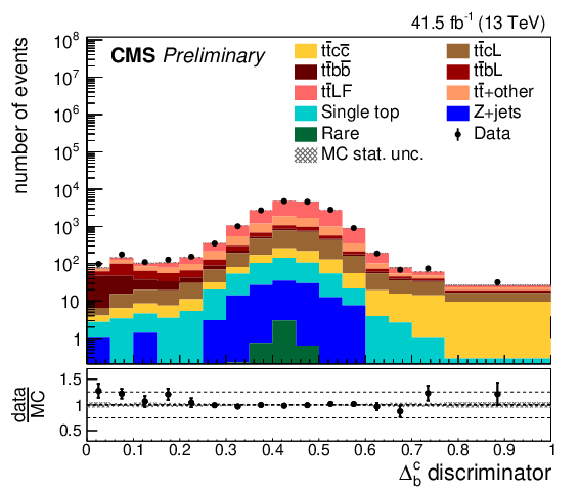
png pdf |
Additional Figure 9:
Comparison between the data (points) and the simulated predictions (histograms) for the distribution of the Δcb discriminator before the fit. |

png pdf |
Additional Figure 10:
Comparison between the data (points) and the simulated predictions (histograms) for the distribution of the ΔcL discriminator before the fit. |

png pdf |
Additional Figure 11:
One-dimensional likelihood scan for the tˉtbˉb cross section in the fiducial phase space, taking into account only the statistical uncertainty in red, and both systematic and statistical uncertainties in black. Intersections with −Δlog(L)= 0.5 and −Δlog(L)= 2 show respectively the 68% and 95% confidence level intervals on the parameter of interest. The theory prediction from the POWHEG + PYTHIA-8 simulation is also shown on the figure with the corresponding 68% confidence level interval superimposed. The latter includes uncertainties from variations of the QCD scales (μR and μF) in the ME, αs uncertainties in the PS and in the proton pdf, uncertainties related to the underlying event and the matching between the ME and the PS (hdamp), as well as the uncertainty on the NNLO tˉt cross section. |

png pdf |
Additional Figure 12:
One-dimensional likelihood scan for the tˉtc¯c cross section in the fiducial phase space, taking into account only the statistical uncertainty in red, and both systematic and statistical uncertainties in black. Intersections with −Δlog(L)= 0.5 and −Δlog(L)= 2 show respectively the 68% and 95% confidence level intervals on the parameter of interest. The theory prediction from the POWHEG + PYTHIA-8 simulation is also shown on the figure with the corresponding 68% confidence level interval superimposed. The latter includes uncertainties from variations of the QCD scales (μR and μF) in the ME, αs uncertainties in the PS and in the proton pdf, uncertainties related to the underlying event and the matching between the ME and the PS (hdamp), as well as the uncertainty on the NNLO tˉt cross section. |
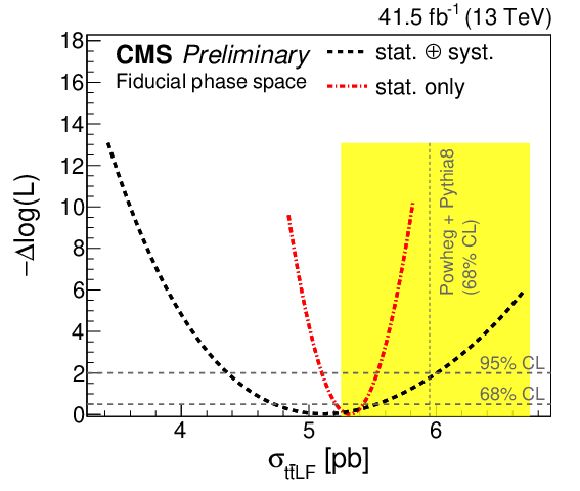
png pdf |
Additional Figure 13:
One-dimensional likelihood scan for the tˉtLF cross section in the fiducial phase space, taking into account only the statistical uncertainty in red, and both systematic and statistical uncertainties in black. Intersections with −Δlog(L)= 0.5 and −Δlog(L)= 2 show respectively the 68% and 95% confidence level intervals on the parameter of interest. The theory prediction from the POWHEG + PYTHIA-8 simulation is also shown on the figure with the corresponding 68% confidence level interval superimposed. The latter includes uncertainties from variations of the QCD scales (μR and μF) in the ME, αs uncertainties in the PS and in the proton pdf, uncertainties related to the underlying event and the matching between the ME and the PS (hdamp), as well as the uncertainty on the NNLO tˉt cross section. |

png pdf |
Additional Figure 14:
One-dimensional likelihood scan for the ratio Rb in the fiducial phase space, taking into account only the statistical uncertainty in red, and both systematic and statistical uncertainties in black. Intersections with −Δlog(L)= 0.5 and −Δlog(L)= 2 show respectively the 68% and 95% confidence level intervals on the parameter of interest. The theory prediction from the POWHEG + PYTHIA-8 simulation is also shown on the figure with the corresponding 68% confidence level interval superimposed. The latter includes uncertainties from variations of the QCD scales (μR and μF) in the ME, αs uncertainties in the PS and in the proton pdf, uncertainties related to the underlying event and the matching between the ME and the PS (hdamp), as well as the uncertainty on the NNLO tˉt cross section. |

png pdf |
Additional Figure 15:
One-dimensional likelihood scan for the ratio Rc in the fiducial phase space, taking into account only the statistical uncertainty in red, and both systematic and statistical uncertainties in black. Intersections with −Δlog(L)= 0.5 and −Δlog(L)= 2 show respectively the 68% and 95% confidence level intervals on the parameter of interest. The theory prediction from the POWHEG +PYTHIA-8 simulation is also shown on the figure with the corresponding 68% confidence level interval superimposed. The latter includes uncertainties from variations of the QCD scales (μR and μF) in the ME, αs uncertainties in the PS and in the proton pdf, uncertainties related to the underlying event and the matching between the ME and the PS (hdamp), as well as the uncertainty on the NNLO tˉt cross section. |

png pdf |
Additional Figure 16:
A one-dimensional representation of the two-dimensional ΔcL and Δcb distributions, in the simulation and in data before performing the fit. The bottom panel shows the ratio of the yields in data to those in the simulation. The brown (grey) uncertainty band denotes the statistical uncertainty from the simulation (the statistical and systematic uncertainties combined). |
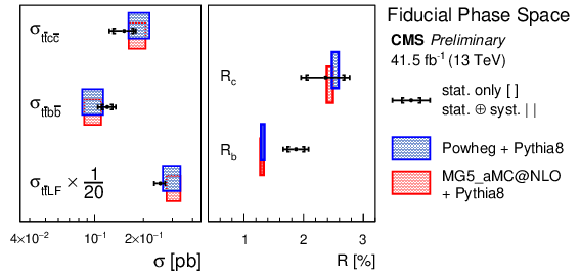
png pdf |
Additional Figure 17:
Summary of the measured cross sections and ratios for the fiducial phase space, compared to predictions from the POWHEG and MG5_aMC@NLO matrix element generators, interfaced with PYTHIA-8 for the parton shower. |
| References | ||||
| 1 | A. Bredenstein, A. Denner, S. Dittmaier, and S. Pozzorini | NLO QCD corrections to tˉtbˉb production at the LHC: 1. Quark-antiquark annihilation | JHEP 08 (2008) 108 | 0807.1248 |
| 2 | A. Bredenstein, A. Denner, S. Dittmaier, and S. Pozzorini | NLO QCD corrections to pp →tˉtbˉb + X at the LHC | PRL 103 (2009) 012002 | 0905.0110 |
| 3 | T. Je\vzo, J. M. Lindert, N. Moretti, and S. Pozzorini | New NLOPS predictions for tˉt+b-jet production at the LHC | EPJC 78 (2018), no. 6, 502 | 1802.00426 |
| 4 | CMS Collaboration | Measurement of the cross section ratio σtˉtbˉb/σtˉtjj in pp collisions at √s= 8 TeV | PLB 746 (2015) 132 | CMS-TOP-13-010 1411.5621 |
| 5 | CMS Collaboration | Measurements of tˉt cross sections in association with b jets and inclusive jets and their ratio using dilepton final states in pp collisions at √s= 13 TeV | PLB 776 (2018) 355 | CMS-TOP-16-010 1705.10141 |
| 6 | CMS Collaboration | Measurement of the cross section for tˉt production with additional jets and b jets in pp collisions at √s= 13 TeV | JHEP 07 (2020) 125 | CMS-TOP-18-002 2003.06467 |
| 7 | CMS Collaboration | Measurement of the tˉtbˉb production cross section in the all-jet final state in pp collisions at √s= 13 TeV | PLB 803 (2020) 135285 | CMS-TOP-18-011 1909.05306 |
| 8 | ATLAS Collaboration | Study of heavy-flavor quarks produced in association with top-quark pairs at √s= 7 TeV using the ATLAS detector | PRD 89 (2014) | 1304.6386 |
| 9 | ATLAS Collaboration | Measurements of fiducial cross-sections for tˉt production with one or two additional b-jets in pp collisions at √s= 8 TeV using the ATLAS detector | EPJC 76 (2016) 11 | 1508.06868 |
| 10 | ATLAS Collaboration | Measurements of inclusive and differential fiducial cross-sections of tˉt production with additional heavy-flavour jets in proton-proton collisions at √s= 13 TeV with the ATLAS detector | JHEP 04 (2019) 046 | 1811.12113 |
| 11 | CMS Collaboration | Identification of c-quark jets at the CMS experiment | CMS-PAS-BTV-16-001 | CMS-PAS-BTV-16-001 |
| 12 | CMS Collaboration | Identification of heavy-flavour jets with the CMS detector in pp collisions at 13 TeV | JINST 13 (2018) P05011 | CMS-BTV-16-002 1712.07158 |
| 13 | CMS Collaboration | Observation of tˉtH production | PRL 120 (2018), no. 23, 231801 | CMS-HIG-17-035 1804.02610 |
| 14 | CMS Collaboration | Search for tˉtH production in the H→bˉb decay channel with leptonic tˉt decays in proton-proton collisions at √s= 13 TeV | JHEP 03 (2019) 026 | CMS-HIG-17-026 1804.03682 |
| 15 | ATLAS Collaboration | Observation of Higgs boson production in association with a top quark pair at the LHC with the ATLAS detector | PLB 784 (2018) 173 | 1806.00425 |
| 16 | ATLAS Collaboration | Search for the standard model Higgs boson produced in association with top quarks and decaying into a bˉb pair in pp collisions at √s= 13 TeV with the ATLAS detector | PRD 97 (2018), no. 7, 072016 | 1712.08895 |
| 17 | P. Nason | A New method for combining NLO QCD with shower Monte Carlo algorithms | JHEP 11 (2004) 040 | hep-ph/0409146 |
| 18 | S. Frixione, P. Nason, and C. Oleari | Matching NLO QCD computations with Parton Shower simulations: the POWHEG method | JHEP 11 (2007) 070 | 0709.2092 |
| 19 | S. Alioli, P. Nason, C. Oleari, and E. Re | A general framework for implementing NLO calculations in shower Monte Carlo programs: the POWHEG BOX | JHEP 06 (2010) 043 | 1002.2581 |
| 20 | J. M. Campbell, R. K. Ellis, P. Nason, and E. Re | Top-Pair Production and Decay at NLO Matched with Parton Showers | JHEP 04 (2015) 114 | 1412.1828 |
| 21 | S. Frixione, P. Nason, and G. Ridolfi | A Positive-weight next-to-leading-order Monte Carlo for heavy flavour hadroproduction | JHEP 09 (2007) 126 | 0707.3088 |
| 22 | T. Sjostrand, S. Mrenna, and P. Z. Skands | A Brief Introduction to PYTHIA 8.1 | CPC 178 (2008) 852 | 0710.3820 |
| 23 | CMS Collaboration | Extraction and validation of a new set of CMS PYTHIA8 tunes from underlying-event measurements | EPJC 80 (2020) 4 | CMS-GEN-17-001 1903.12179 |
| 24 | NNPDF Collaboration | Parton distributions from high-precision collider data | EPJC 77 (2017), no. 10, 663 | 1706.00428 |
| 25 | M. Cacciari et al. | Top-pair production at hadron colliders with next-to-next-to-leading logarithmic soft-gluon resummation | PLB 710 (2012) 612 | 1111.5869 |
| 26 | J. Alwall et al. | The automated computation of tree-level and next-to-leading order differential cross sections, and their matching to parton shower simulations | JHEP 07 (2014) 079 | 1405.0301 |
| 27 | R. Frederix and S. Frixione | Merging meets matching in MC@NLO | JHEP 12 (2012) 061 | 1209.6215 |
| 28 | J. Alwall et al. | Comparative study of various algorithms for the merging of parton showers and matrix elements in hadronic collisions | EPJC 53 (2008) 473 | 0706.2569 |
| 29 | GEANT4 Collaboration | GEANT4--a simulation toolkit | NIMA 506 (2003) 250 | |
| 30 | M. Cacciari and G. P. Salam | Pileup subtraction using jet areas | PLB 659 (2008) 119 | 0707.1378 |
| 31 | M. Cacciari, G. P. Salam, and G. Soyez | The anti-kt jet clustering algorithm | JHEP 04 (2008) 063 | 0802.1189 |
| 32 | M. Cacciari, G. P. Salam, and G. Soyez | FastJet User Manual | EPJC 72 (2012) 1896 | 1111.6097 |
| 33 | CMS Collaboration | Particle-flow reconstruction and global event description with the cms detector | JINST 12 (2017) P10003 | CMS-PRF-14-001 1706.04965 |
| 34 | CMS Collaboration | Jet energy scale and resolution in the CMS experiment in pp collisions at 8 TeV | JINST 12 (2017) P02014 | CMS-JME-13-004 1607.03663 |
| 35 | CMS Collaboration | Performance of missing transverse momentum reconstruction in proton-proton collisions at √s= 13 TeV using the CMS detector | JINST 14 (2019) P07004 | CMS-JME-17-001 1903.06078 |
| 36 | CMS Collaboration | The CMS trigger system | JINST 12 (2017) P01020 | CMS-TRG-12-001 1609.02366 |
| 37 | F. Chollet et al. | KERAS | https://github.com/keras-team/keras | |
| 38 | M. Abadi et al. | TensorFlow: Large-scale machine learning on heterogeneous systems | 2015 Software available from tensorflow.org. \url https://www.tensorflow.org/ | |
| 39 | CMS Collaboration | A search for the standard model Higgs boson decaying to charm quarks | JHEP 03 (2020) 131 | CMS-HIG-18-031 1912.01662 |
| 40 | A. Savitzky and M. Golay | Smoothing and differentiation of data by simplified least squares procedures | Analytical chemistry 36 (07, 1964) 1627 | |
| 41 | CMS Collaboration | Measurement of the inelastic proton-proton cross section at √s= 13 TeV | JHEP 07 (2018) 161 | CMS-FSQ-15-005 1802.02613 |
| 42 | CMS Collaboration | CMS luminosity measurement for the 2017 data-taking period at √s= 13 TeV | CMS-PAS-LUM-17-004 | CMS-PAS-LUM-17-004 |
| 43 | M. Cacciari et al. | The t anti-t cross-section at 1.8-TeV and 1.96-TeV: A Study of the systematics due to parton densities and scale dependence | JHEP 04 (2004) 068 | hep-ph/0303085 |
| 44 | S. Catani, D. de Florian, M. Grazzini, and P. Nason | Soft gluon resummation for Higgs boson production at hadron colliders | JHEP 07 (2003) 028 | hep-ph/0306211 |
| 45 | CMS Collaboration | Investigations of the impact of the parton shower tuning in Pythia 8 in the modelling of tˉt at √s= 8 and 13 TeV | CMS-PAS-TOP-16-021 | CMS-PAS-TOP-16-021 |
| 46 | CMS Collaboration | Extraction and validation of a new set of CMS PYTHIA8 tunes from underlying-event measurements | CMS-PAS-GEN-17-001 | CMS-PAS-GEN-17-001 |
| 47 | CMS Collaboration | Electroweak production of two jets in association with a Z boson in proton--proton collisions at √s= 13 TeV | EPJC 78 (2018), no. 7, 589 | CMS-SMP-16-018 1712.09814 |
| 48 | CMS Collaboration | Measurement of the single top quark and antiquark production cross sections in the t channel and their ratio in proton-proton collisions at √s= 13 TeV | PLB 800 (2020) 135042 | CMS-TOP-17-011 1812.10514 |

|
Compact Muon Solenoid LHC, CERN |

|

|

|

|

|

|